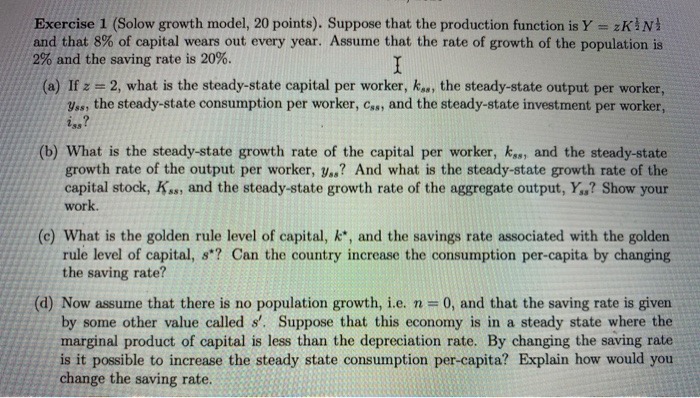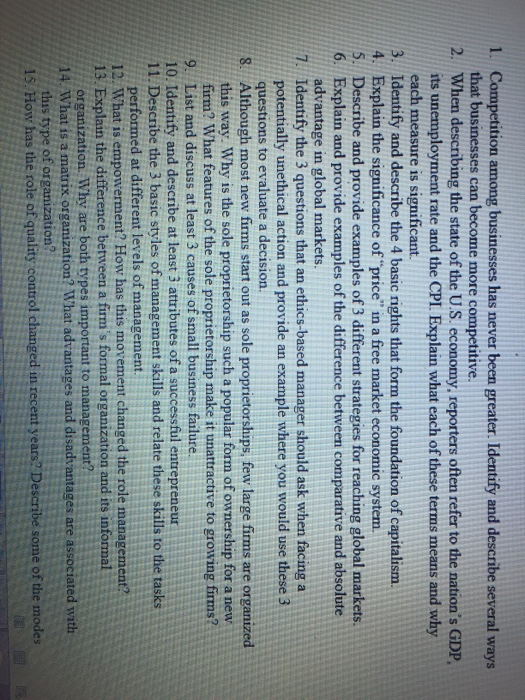Question
. Explain the following questions correctly. Question 1: Simple Solow Growth Models Consider the following story of Robinson Crusoe. There is a single good that
. Explain the following questions correctly.
Question 1: Simple Solow Growth Models Consider the following story of Robinson Crusoe. There is a single good that can be combined with labour to produce itself. Think of Robinson using coconuts and his own labour to grow more coconuts. In each period Robinson has some amount of coconuts that he uses to produce more. Call this amount K. When combined with his labour input, L, the result will be a net increase of coconuts equal to Y. The net production function is given by; Yt = F(Kt, Lt) = At(Kt) ? (Lt) 1-? (1) where A measures total factor productivity, K is the number of coconuts used as capital goods, L is the labour input, and ? is in the (0,1) interval. That this is a net production function simply means that Y is the amount of additional coconuts that RC gets through the production process; he also has the initial coconuts that he used as inputs, after ? percent of them depreciate through use. The total labour-force of Crusoes (all identical) increases as follows: Lt = (1+n)Lt-1 (2) Finally, all members of the Crusoe Family save a constant fraction, s, of their net production. This is basically the Solow growth model. a) Derive the equation that shows the evolution of the capital per worker (k = K/L). Show the condition which must be satisfied in the steady state where k is constant. Explain, intuitively, why this condition makes sense. b) If savings rate is 15%, Labor growth rate is 2%, the depreciation rate is 10%, At = 10 and ? = 0.30, calculate the value of the steady-state per capita stock of coconuts, (k*), steady-state per capita output (y*) and steady-state per capita consumption (c*). Show in a diagram the unique non-zero steady-state value of k*. What is the growth rate of K/L, Y/L, and C/L. c) If the economy is initially in a steady state and At increases to 12, describe the growth path of K/L and Y/L as we move to another steady state. Show the process in a diagram. d) Given that now At = 12, calculate the new values of the steady-state per capita stock of coconuts, (k*), steady-state per capita output (y*) and steady-state per capita consumption (c*). Show in a diagram the unique non-zero steady-state value of k*. Suppose now that the Crusoes decided that they would no longer arbitrarily choose to save the fraction s of their net production. Instead, their goal is to maximize the value of per capita consumption in steady state. Though the Crusoes do not know it, they are now attempting to find what is called the "golden rule" level of k and c. Noting that nothing else in the economy has changed, except that At = 12, it should be clear that the evolution of the per capita stock of coconuts is now given by dk/dt = f(kt) - ct - (? + n)kt (3) e) Show what condition must be satisfied at the "golden rule" level of k and c. Using the production function given, calculate the value of steady-state k, y, and c in this new economy and compare them to the steady-state values in the original economy with At = 12. Why are the two equilibriums not the same? What will they do to get to the "golden rule" values? f) Now if the per capita output (Y/L) = AK/L, Plot the output, required investment, and actual savings functions on a graph (for a case where savings is greater than required investment right from the start). Is there a unique steady state? h) What is the steady state growth for Y, K, (Y/L) and (K/L)
No other information available --- please advise on basic details at least


Step by Step Solution
There are 3 Steps involved in it
Step: 1

Get Instant Access to Expert-Tailored Solutions
See step-by-step solutions with expert insights and AI powered tools for academic success
Step: 2

Step: 3

Ace Your Homework with AI
Get the answers you need in no time with our AI-driven, step-by-step assistance
Get Started


